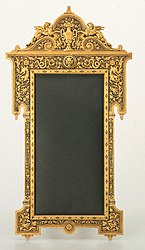File:Khalili Collection Spanish Damascened Metalwork ZUL126.jpg

Original file (2,500 × 4,306 pixels, file size: 2.31 MB, MIME type: image/jpeg)
| This is a file from the Wikimedia Commons. Information from its description page there is shown below. Commons is a freely licensed media file repository. You can help. |
Contents
Summary
Object
| Frame
|
|||||||||||||||||||||
|---|---|---|---|---|---|---|---|---|---|---|---|---|---|---|---|---|---|---|---|---|---|
| Title |
Frame label QS:Len,"Frame" |
||||||||||||||||||||
| Object type |
metal artwork / picture frame |
||||||||||||||||||||
| Description |
English: This frame is constructed in two parts; the front is profusely ornamented with gold damascene over a finely hatched ground and with fourteen chiselled and gilded appliqués. The inscription on the removable back, which consists of a single iron plate, reads: 'Mendizlábal and Company, Eibar, Made for F.A. Almier, Lisbon'. This type of frame, having most of its surface in the upper half, is peculiar to Eibar, but it may have its inspiration in eighteenth-century models. The style is first encountered among pieces produced by Plácido Zuloaga during the final two decades of the nineteenth century, and frames of this outline were included in the repertoire of Eibar damascening houses until at least the Spanish Civil War (1936-39). The style is suggestive of a doorway with an exaggerated pediment whose purpose is to offer a broad background for damascene ornament. Some examples even have a backplate with damascened human figures which, when there is no picture or mirror in place, reinforce this impression. Many of these frames have designs of Eastern inspiration (see ZUL 23). There is, however, a small group of frames of similar format decorated in what was called in Eibar renacimiento (Renaissance) style, which included Renaissance, baroque, and neoclassical elements, some derived directly from contemporary pattern albums. The defined pediment applied over the frame's 'lintel' contributes to its architectural appearance. A broken scroll, surmounted by applied golden griffins worked in the round, flanks a classical urn capped by a horseshoe arch. A plain gold band encircles the entire frame; on the pediment and adjacent upper portion, there is an inner band of matte gold with beading. Enclosed within these borders, the black background sets off baroque floral damascening executed in 'red' and 'green' gold wire, small elements in silver leaf, applied medallions, and three-dimensional golden figures, including serpents and grotesque beasts. The inner border of the frame is bevelled and surrounded by a gold border with floral rosettes and beads. The style of ornament that combines wire damascening with three-dimensional gold and silver appliqués appears to have come into vogue around the turn of the century. The concept of applied figures may derive from the dark iron chiselled relief used by Eusebio Zuloaga around the middle of the century. This was subsequently reflected in the sculptured handles of Plácidos urns (see ZUL 94). Three-dimensional chiselling, black and gilt, became prominent towards the very end of the nineteenth century and continue well into the twentieth. The two Mendizlábals currently recorded are Fausto, the principal designer of the Loiola altar, and his son Toribio, who kept a workshop after his father's death. This shop may have become Mendizábal y Compañía, the producers of this frame. Given the vagueness of this chronology, the suggested date of 1900 for the frame's production is based mainly on its style and technique rather than family history. |
||||||||||||||||||||
| Date |
circa |
||||||||||||||||||||
| Medium | iron, gold and silver damascene, glass | ||||||||||||||||||||
| Collection |
institution QS:P195,Q63160499 |
||||||||||||||||||||
| Accession number | |||||||||||||||||||||
| Place of creation |
Eibar |
||||||||||||||||||||
| References |
https://www.khalilicollections.org/collections/spanish-damascened-metalwork/khalili-collection-spanish-damascened-metalwork-frame-zul126/ (English) |
||||||||||||||||||||
| Permission (Reusing this file) |
|
||||||||||||||||||||
Photograph
| Author | Khalili Foundation | ||
| Permission (Reusing this file) |
|
Licensing
- You are free:
- to share – to copy, distribute and transmit the work
- to remix – to adapt the work
- Under the following conditions:
- attribution – You must give appropriate credit, provide a link to the license, and indicate if changes were made. You may do so in any reasonable manner, but not in any way that suggests the licensor endorses you or your use.
Captions
File history
Click on a date/time to view the file as it appeared at that time.
| Date/Time | Thumbnail | Dimensions | User | Comment | |
|---|---|---|---|---|---|
| current | 18:05, 5 November 2020 |  | 2,500 × 4,306 (2.31 MB) | MartinPoulter | Opened and saved in IrfanView to fix colours |
| 18:09, 3 November 2020 |  | 2,500 × 4,306 (2.18 MB) | MartinPoulter | pattypan 20.04 |
File usage
The following page uses this file:
Global file usage
The following other wikis use this file:
- Usage on www.wikidata.org
Metadata
This file contains additional information, probably added from the digital camera or scanner used to create or digitize it.
If the file has been modified from its original state, some details may not fully reflect the modified file.
| Copyright holder |
|
|---|---|
| Width | 2,500 px |
| Height | 4,306 px |
| Compression scheme | Uncompressed |
| Pixel composition | Separated (Probably CMYK) |
| Orientation | Normal |
| Number of components | 4 |
| Horizontal resolution | 341 dpi |
| Vertical resolution | 341 dpi |
| Data arrangement | chunky format |
| Software used | Adobe Photoshop CS6 (Macintosh) |
| File change date and time | 16:07, 11 December 2018 |
| Color space | Uncalibrated |
| Unique ID of original document | adobe:docid:photoshop:dd9a9e5f-c762-11d8-b286-b5c209153efc |
| Date and time of digitizing | 13:09, 22 November 2018 |
| Date metadata was last modified | 16:07, 11 December 2018 |
| Copyright status | Copyrighted |


